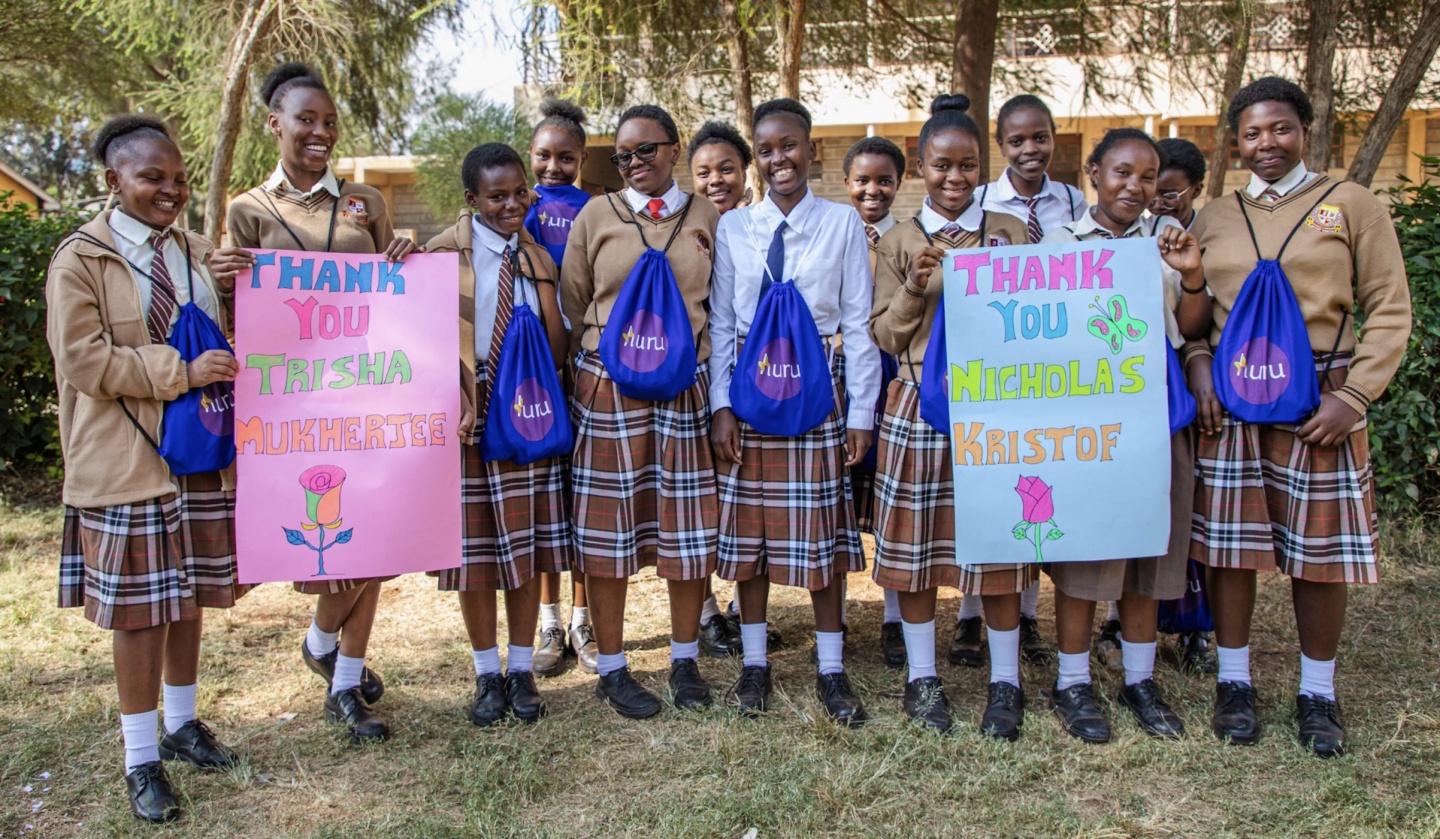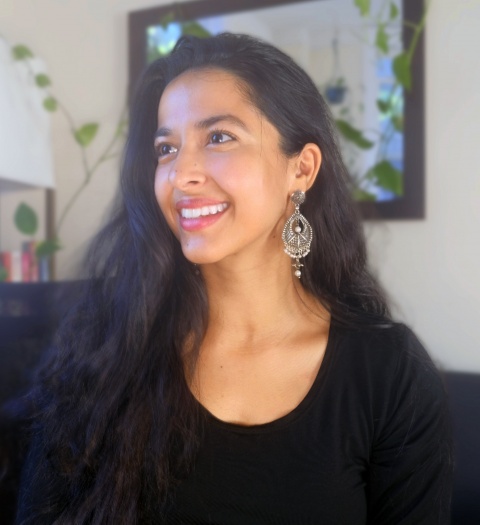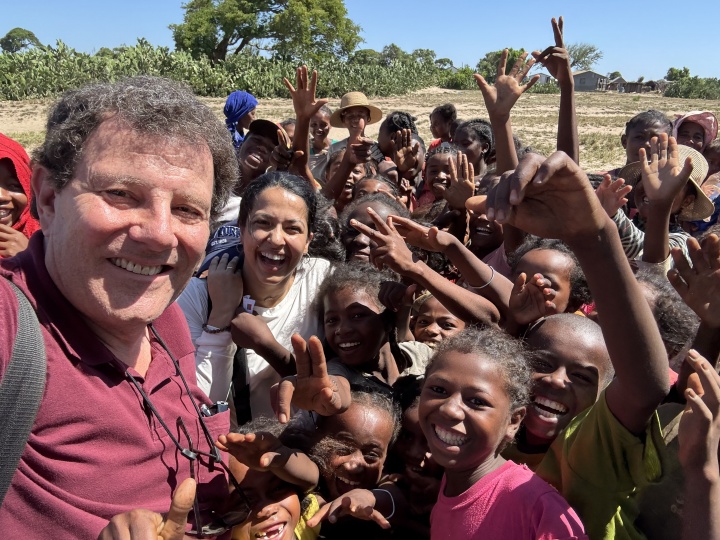Trisha Mukherjee ’21, JRN’24’s reporting on period poverty has helped more than 14,000 girls stay in school.
Columbia College | Columbia University in the City of New York
Trisha Mukherjee ’21, JRN’24’s reporting on period poverty has helped more than 14,000 girls stay in school.

Girls who received Huru kits thanked Mukherjee and New York Times columnist Nicholas Kristof for their reporting at a distribution event on International Women’s Day.
COURTESY HURU INTERNATIONAL
At first, journalist Trisha Mukherjee ’21, JRN’24 didn’t believe what she was hearing. She was on a reporting trip in Madagascar, interviewing 16-year-old Vola Liamarinee Florence about trying to go to school while on her period in a country where menstruation is highly stigmatized. Florence told her that she regularly washed and reused disposable pads three times before discarding them, as period products are expensive and hard to come by.
Mukherjee thought she misunderstood. Surely, Florence didn’t mean the thin, flimsy pads that most Westerners don’t think twice about throwing away after one use?
As Mukherjee continued her questions, she soon realized Florence was talking about disposable menstrual pads. Washing and reusing them was her only option — and not a good one. Reused pads are prone to leaking and because menstrual blood is considered so taboo, Florence was missing about four days of school every month.
Florence’s experience stuck with Mukherjee. “I started thinking about my own life — how much of a privilege it is to go to school, and to have your period just be a matter of going to the store to buy pads,” she says. “And honestly, I got really mad about it. These girls weren’t able to get an education because of something so natural. I realized that I really wanted to write about it.”

Trisha Mukherjee ’21, JRN’24
Mukherjee’s compelling reporting came after winning Times columnist Nicholas Kristof’s annual journalism contest in 2024. Each year, Kristof selects one undergraduate or graduate student to join him on an all-expenses paid reporting trip to cover neglected global issues. He and Mukherjee traveled to Kenya, Mauritius and Madagascar to write about health issues facing women in those regions and to connect with nonprofits that are addressing those needs in rural communities. She wrote three stories total, but says the one about period poverty was particularly resonant.
“I talked to girls who were given reusable pads by nonprofits, and that totally changed their lives,” Mukherjee says. “I also talked to girls who struggled through school and went anyway, and who are now determined to make sure other girls in their community have access to period products. It was just amazing to have those conversations and hear their perspectives.”
Mukherjee’s passion for human rights and storytelling stems from her own family history. Her grandmother, one of her “best friends,” was a child during the 1947 partition of India, when the British ended colonial rule with hastily redrawn borders, leaving millions of Hindus and Muslims at risk of communal violence. Mukherjee’s grandmother was forced to flee from her home in what is now Bangladesh.
“Suddenly, her family was on the wrong side of the border,” Mukherjee says. “She had to abandon everything and cross over as her house was going up in flames.”
Mukherjee says she realized how fortunate she was to be trusted with her grandmother’s recollections of refugee life, as well as the power of stories to illuminate injustice.
Mukherjee also cites Kristof’s book Half the Sky: Turning Oppression Into Opportunity for Women Worldwide as a source of inspiration. After reading it as a teenager, she wanted to get involved in combatting human trafficking, and looked for an organization to volunteer with. But no one would take on the liabilities associated with having a high schooler on the team.
So, Mukherjee turned to what she knew she could do to have an impact — tell stories. She reached out to activists and survivors worldwide who were fighting against human trafficking and asked for interviews. Pre-Zoom, she dipped her toe into the journalistic waters for the first time via Skype calls from her home in New Jersey. The project culminated in a self-published book, Leading Lights: Interviews with Anti-trafficking Activists.
“The good thing about storytelling is that your age or background doesn’t really matter — stories are meant to be shared.”
“Looking back, I really had no idea what I was doing, but I was lucky that the people I talked to were so kind and patient,” she says. “The good thing about storytelling is that your age or background doesn’t really matter — stories are meant to be shared.”
At the College, Mukherjee studied human rights, working in legal clinics focused on assisting immigrants. Her experience helping a woman look for her brother, who had gone missing while crossing the U.S.-Mexican border, stayed with her for years.
“There are a lot of people who don’t know where their family members are if they disappear crossing the border,” she says. “I was calling morgues and nonprofits and search and rescue groups; we eventually located her brother. He had passed away, but it did give her a sense of closure.”
Mukherjee returned to Columbia to pursue a master’s at the Journalism School, where she reported on missing migrants in the Sonoran Desert for her thesis. She found even more human rights-centered narratives, including one that came out of a J-School exercise in good old-fashioned “shoe leather reporting” — hitting the street to look for ideas. While talking to a priest in the Bronx who mentioned protesting outside of a now-closed abortion clinic, Mukherjee’s ears perked.
“It led me down a rabbit hole, trying to reconstruct the decades-long lifespan of this clinic that had been so central to reproductive healthcare in the borough,” she says. “None of this had been covered before.”
Mukherjee’s piece detailed the loss of Bronx Abortion through the perspectives of volunteer escorts, all of whom recognized how hard the clinic’s absence would hit the surrounding community. The work helped her to see how many of her journalistic interests overlapped.
“I realized how intersectional a lot of these issues are,” Mukherjee says. “You can’t report on just one in isolation.”
Mukherjee’s desire to spotlight injustices in her reporting made her a prime candidate for Kristof’s contest. She had been eyeing it for a while, but this was the first year she felt qualified to enter. Kristof, who has been running the contest since 2006, was thoroughly impressed.
“Trisha stood out among an enormous number of applicants because she didn’t just aspire to be a terrific journalist; she already was one,” he says.

Mukherjee and Kristof with village children in Madagascar.
She was surprised by how openly and candidly the girls spoke about their periods and experiences navigating societal stigmas. “It felt like they had been waiting to talk about it and how [the taboos] interfered with their school and life,” she says.
Mukherjee sat down to write after returning from the trip in December 2024. She organized her notes and transcripts and, under the guidance of Kristof and his editors at the Times, went through rounds and rounds of editing and fact-checking. Finally, it was time for the story to go live.
“I was a little nervous because I had never published something in an outlet like The New York Times,” Mukherjee says. “But the response was incredible.”
After Huru International’s work was featured by Mukherjee, the nonprofit received a flood of donations and letters. “I can’t imagine what it would have been like if I didn’t have even the most basic of personal care supplies,” one donor wrote.
The impact has been profound. Thanks to more than a half-million dollars in donations, Huru was able to provide kits with reusable period products, soap, storage supplies and educational materials to 14,700 Kenyan girls.
“We are deeply moved by the generous support sparked by Trisha’s powerful storytelling,” says Lorna Macleod, Huru’s founder and executive director. “Her reporting has driven hundreds of new conversations and several new partnerships, bringing us closer to making menstrual equity a reality.”
Mukherjee knows she won’t forget Florence and the other girls she met, and that she’ll carry the lessons from her experience forward. In the meantime, seeing the direct effect of her journalism has been deeply rewarding.
“Sometimes it can feel like you’re writing into the void, so seeing that people do care has been amazing,” she says. “I read Nick’s work and felt motivated to do something about the issues he wrote about, so to see that people felt the same about my story filled my heart.”

Published three times a year by Columbia College for alumni, students, faculty, parents and friends.
Columbia Alumni Center
622 W. 113th St., MC 4530, 6th Fl.
New York, NY 10025
212-851-7852
cct@columbia.edu

Columbia Alumni Center
622 W. 113th St., MC 4530, 4th Fl.
New York, NY 10025
212-851-7488
ccalumni@columbia.edu